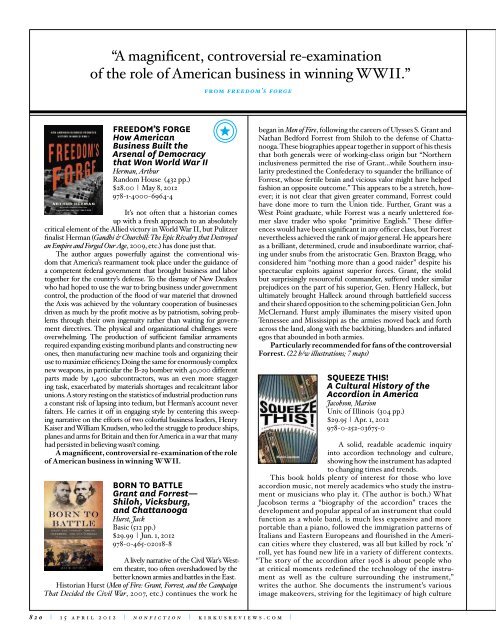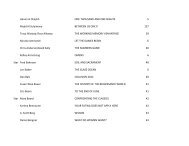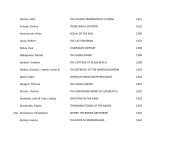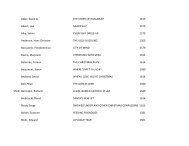nonfiction
nonfiction
nonfiction
You also want an ePaper? Increase the reach of your titles
YUMPU automatically turns print PDFs into web optimized ePapers that Google loves.
“A magnificent, controversial re-examination<br />
of the role of American business in winning WWII.”<br />
from freedom’s forge<br />
FREEDOM’S FORGE<br />
How American<br />
Business Built the<br />
Arsenal of Democracy<br />
that Won World War II<br />
Herman, Arthur<br />
Random House (432 pp.)<br />
$28.00 | May 8, 2012<br />
978-1-4000-6964-4<br />
It’s not often that a historian comes<br />
up with a fresh approach to an absolutely<br />
critical element of the Allied victory in World War II, but Pulitzer<br />
finalist Herman (Gandhi & Churchill: The Epic Rivalry that Destroyed<br />
an Empire and Forged Our Age, 2009, etc.) has done just that.<br />
The author argues powerfully against the conventional wisdom<br />
that America’s rearmament took place under the guidance of<br />
a competent federal government that brought business and labor<br />
together for the country’s defense. To the dismay of New Dealers<br />
who had hoped to use the war to bring business under government<br />
control, the production of the flood of war materiel that drowned<br />
the Axis was achieved by the voluntary cooperation of businesses<br />
driven as much by the profit motive as by patriotism, solving problems<br />
through their own ingenuity rather than waiting for government<br />
directives. The physical and organizational challenges were<br />
overwhelming. The production of sufficient familiar armaments<br />
required expanding existing moribund plants and constructing new<br />
ones, then manufacturing new machine tools and organizing their<br />
use to maximize efficiency. Doing the same for enormously complex<br />
new weapons, in particular the B-29 bomber with 40,000 different<br />
parts made by 1,400 subcontractors, was an even more staggering<br />
task, exacerbated by materials shortages and recalcitrant labor<br />
unions. A story resting on the statistics of industrial production runs<br />
a constant risk of lapsing into tedium, but Herman’s account never<br />
falters. He carries it off in engaging style by centering this sweeping<br />
narrative on the efforts of two colorful business leaders, Henry<br />
Kaiser and William Knudsen, who led the struggle to produce ships,<br />
planes and arms for Britain and then for America in a war that many<br />
had persisted in believing wasn’t coming.<br />
A magnificent, controversial re-examination of the role<br />
of American business in winning WWII.<br />
BORN TO BATTLE<br />
Grant and Forrest—<br />
Shiloh, Vicksburg,<br />
and Chattanooga<br />
Hurst, Jack<br />
Basic (512 pp.)<br />
$29.99 | Jun. 1, 2012<br />
978-0-465-02018-8<br />
A lively narrative of the Civil War’s Western<br />
theatre, too often overshadowed by the<br />
better known armies and battles in the East.<br />
Historian Hurst (Men of Fire: Grant, Forrest, and the Campaign<br />
That Decided the Civil War, 2007, etc.) continues the work he<br />
began in Men of Fire, following the careers of Ulysses S. Grant and<br />
Nathan Bedford Forrest from Shiloh to the defense of Chattanooga.<br />
These biographies appear together in support of his thesis<br />
that both generals were of working-class origin but “Northern<br />
inclusiveness permitted the rise of Grant...while Southern insularity<br />
predestined the Confederacy to squander the brilliance of<br />
Forrest, whose fertile brain and vicious valor might have helped<br />
fashion an opposite outcome.” This appears to be a stretch, however;<br />
it is not clear that given greater command, Forrest could<br />
have done more to turn the Union tide. Further, Grant was a<br />
West Point graduate, while Forrest was a nearly unlettered former<br />
slave trader who spoke “primitive English.” These differences<br />
would have been significant in any officer class, but Forrest<br />
nevertheless achieved the rank of major general. He appears here<br />
as a brilliant, determined, crude and insubordinate warrior, chafing<br />
under snubs from the aristocratic Gen. Braxton Bragg, who<br />
considered him “nothing more than a good raider” despite his<br />
spectacular exploits against superior forces. Grant, the stolid<br />
but surprisingly resourceful commander, suffered under similar<br />
prejudices on the part of his superior, Gen. Henry Halleck, but<br />
ultimately brought Halleck around through battlefield success<br />
and their shared opposition to the scheming politician Gen. John<br />
McClernand. Hurst amply illuminates the misery visited upon<br />
Tennessee and Mississippi as the armies moved back and forth<br />
across the land, along with the backbiting, blunders and inflated<br />
egos that abounded in both armies.<br />
Particularly recommended for fans of the controversial<br />
Forrest. (22 b/w illustrations; 7 maps)<br />
SQUEEZE THIS!<br />
A Cultural History of the<br />
Accordion in America<br />
Jacobson, Marion<br />
Univ. of Illinois (304 pp.)<br />
$29.95 | Apr. 1, 2012<br />
978-0-252-03675-0<br />
A solid, readable academic inquiry<br />
into accordion technology and culture,<br />
showing how the instrument has adapted<br />
to changing times and trends.<br />
This book holds plenty of interest for those who love<br />
accordion music, not merely academics who study the instrument<br />
or musicians who play it. (The author is both.) What<br />
Jacobson terms a “biography of the accordion” traces the<br />
development and popular appeal of an instrument that could<br />
function as a whole band, is much less expensive and more<br />
portable than a piano, followed the immigration patterns of<br />
Italians and Eastern Europeans and flourished in the American<br />
cities where they clustered, was all but killed by rock ’n’<br />
roll, yet has found new life in a variety of different contexts.<br />
“The story of the accordion after 1908 is about people who<br />
at critical moments redefined the technology of the instrument<br />
as well as the culture surrounding the instrument,”<br />
writes the author. She documents the instrument’s various<br />
image makeovers, striving for the legitimacy of high culture<br />
while attempting to shake its associations with cheesiness,<br />
tawdriness (the instrument of the bordello and the saloon)<br />
and working-class ethnicity. Jacobson deservedly shines the<br />
spotlight on a variety of accordionists: Guido Deiro, who<br />
“experienced the most dramatic rise to success in accordion<br />
history” and was once married to Mae West; Dick Contino,<br />
a would-be teen idol; Myron Floren, far more of a virtuoso<br />
than Lawrence Welk; and Frankie Yankovic, a huge crossover<br />
recording success. Yet the author slights the likes of Clifton<br />
Chenier and zydeco, Flaco Jimenez and conjunto, Los Lobos<br />
and Cajun accordion music, focusing more on the less-indigenous<br />
Brave Combo and They Might Be Giants. The “Accordions<br />
Are In!” ad campaign for the Tiger Combo ‘Cordion<br />
reflects the humor here that is too rare in academic writing.<br />
A good start on a rich subject. (20-page color photo insert)<br />
A BATTLE FOR THE<br />
SOUL OF ISLAM<br />
An American Muslim<br />
Patriot’s Fight to<br />
Save His Faith<br />
Jasser, M. Zuhdi<br />
Threshold Editions/Simon<br />
& Schuster (336 pp.)<br />
$26.00 | Jun. 5, 2012<br />
978-1-4516-5794-4<br />
A candid, patriotic pushback against<br />
Muslim stereotyping by a deeply anti-Islamist Navy veteran and<br />
physician in Arizona.<br />
Born in 1967 to Syrian refugees in Ohio, raised in Wisconsin,<br />
a committed conservative and founder of the American<br />
Islamic Forum for Democracy, Jasser has been moved to speak<br />
out by what he believes is the Muslim community’s inadequate<br />
stand against Islamist terrorism and political tribalism. He<br />
believes in the separation of mosque and state and is often horrified<br />
to hear Muslim Americans assert the supremacy of the<br />
Qur’an over the principles of the U.S. Constitution. He details<br />
his background and family, including his unease serving in the<br />
Navy, which was dominated by a hard-drinking, womanizing<br />
culture while he was abstemious and chaste, according to his<br />
religion; and his early professional tensions with his physician<br />
father, who was overbearing, proud and disputatious. Married<br />
in a traditional fashion to another high-achieving young Syrian<br />
American, Jasser settled down to start a family and private<br />
practice in Phoenix as a primary care physician, chosen as part<br />
of his dedication to the “holistic appreciation of the patient”<br />
urged by his Islamic faith. The attacks of 9/11 shattered his complacency,<br />
and Jasser looks hard at the Arab responses, dictated<br />
by what he sees as lingering effects of tribalism. He weighs the<br />
eerie parallels between himself and the Army psychiatrist who<br />
went on a murderous shooting spree at Fort Hood, a tragedy he<br />
blames on Islamist ideology. Branded an “Uncle Tom Muslim,”<br />
Jasser spoke to the House Committee on Homeland Security<br />
against what he calls “PC blindness” to the threat. His paranoia<br />
aside, the author draws from his father’s own translations of<br />
the Qur’an for an intelligent reassessment of its message along<br />
the lines of Jeffersonian democracy.<br />
A strident call to energize Muslim Americans to promote<br />
notions of pluralism, toleration and equal rights for women.<br />
JOHNSON’S LIFE OF LONDON<br />
The People Who Made the<br />
City that Made the World<br />
Johnson, Boris<br />
Riverhead (336 pp.)<br />
$27.95 | Jun. 1, 2012<br />
978-1-59448-747-7<br />
The mayor of London demonstrates<br />
that understanding his city requires an<br />
acquaintance with key historical personages,<br />
from Alfred the Great to Keith Richards.<br />
On the eve of the 2012 Summer Olympics, the author provides<br />
a lively thematic guide to the city’s historical evolution as<br />
represented by the legacy of notable Londoners, ancient and<br />
modern, from the Romans who overran the city to the great<br />
statesman who staunchly defended it from attack, Winston<br />
Churchill. Johnson has served as mayor since 2008, previously<br />
the editor of The Spectator and thus a trained, amiable journalist.<br />
With an engaging, felicitous tone, the author obviously enjoys<br />
offering his account of what the English have done best, from<br />
spreading the good word in the form of the King James Bible<br />
to parliamentary democracy and habeas corpus to the marvels<br />
of the English language. Johnson pays tribute to numerous<br />
illustrious Londoners, some better known than others—e.g.,<br />
the early avenger Boudica, the first in a tradition of powerful<br />
female leaders; a previous mayor, 15th-century financier Richard<br />
Whittington; a fabulously inventive, now-forgotten genius<br />
of the 17th century, Robert Hooke; eccentric civil libertarian<br />
John Wilkes; Samuel Johnson and his lexicographic wit; saintly<br />
nurses Florence Nightingale and Mary Seacole, who challenged<br />
notions of hygiene and ventilation in the treatment of disease;<br />
and W.T. Stead, inventor of tabloid journalism with his work<br />
on the Pall Mall Gazette in the mid 19th century. Along the way<br />
there are shorter bios of some incredibly important innovators<br />
and inventors, such as Sir John Harington, godson of Queen<br />
Elizabeth I and fashioner of the flush toilet of which she was<br />
so fond; Beau Brummel and his now-ubiquitous men’s suit; and<br />
Denis Johnson and his significant modifications on the bicycle<br />
in 19th-century London.<br />
In this amusing, rah-rah pep rally for the imminent crush<br />
of summer tourists, the author shows that there is much<br />
more to London than Big Ben, London Bridge and William<br />
Shakespeare.<br />
820 | 15 april 2012 | <strong>nonfiction</strong> | kirkusreviews.com |<br />
| kirkusreviews.com | <strong>nonfiction</strong> | 15 april 2012 | 821






